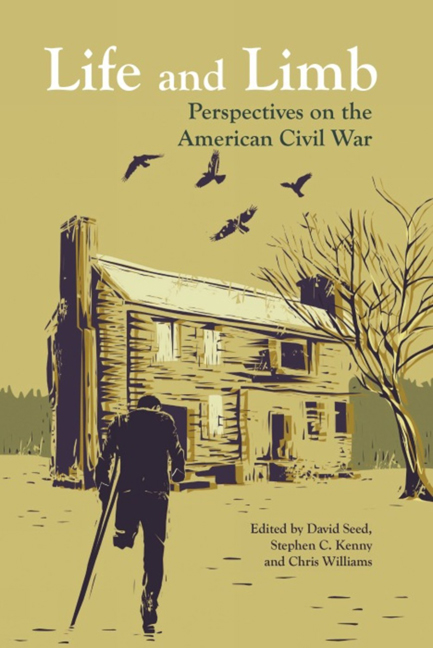Book contents
- Frontmatter
- Contents
- List of Illustrations
- Acknowledgements
- Introduction: Civil War Voices and Views
- MEDICAL AND SURGICAL MEMOIRS
- ACCOUNTS OF NURSING
- MEDICAL FACILITIES AND PATHOLOGY
- PHOTOGRAPHY
- AMPUTATIONS AND PROSTHETIC LIMBS
- ‘The Invalid Corps’ (song)
- The Case of Napoleon Perkins
- The First Amputee: ‘Record of Services’
- Testimonial Letter
- The Salem Leg (brochure)
- Testimony of Wearers (The Salem Leg: Under the Patronage of the United States Government for the Use of the Army and the Navy)
- The Human Wheel: ‘The Human Wheel, Its Spokes and Felloes’
- ‘The Case of George Dedlow’
- ‘Phantom Limbs’
- IN THE FIELD OF BATTLE
- POST-WAR NARRATIVES
- Contributors
- Select Bibliography
- Index
- Plates
The Case of Napoleon Perkins
from AMPUTATIONS AND PROSTHETIC LIMBS
- Frontmatter
- Contents
- List of Illustrations
- Acknowledgements
- Introduction: Civil War Voices and Views
- MEDICAL AND SURGICAL MEMOIRS
- ACCOUNTS OF NURSING
- MEDICAL FACILITIES AND PATHOLOGY
- PHOTOGRAPHY
- AMPUTATIONS AND PROSTHETIC LIMBS
- ‘The Invalid Corps’ (song)
- The Case of Napoleon Perkins
- The First Amputee: ‘Record of Services’
- Testimonial Letter
- The Salem Leg (brochure)
- Testimony of Wearers (The Salem Leg: Under the Patronage of the United States Government for the Use of the Army and the Navy)
- The Human Wheel: ‘The Human Wheel, Its Spokes and Felloes’
- ‘The Case of George Dedlow’
- ‘Phantom Limbs’
- IN THE FIELD OF BATTLE
- POST-WAR NARRATIVES
- Contributors
- Select Bibliography
- Index
- Plates
Summary
The most vivid memory Napoleon Perkins could still remember from the Battle of Chancellorsville was the ‘limbs, leaves, and blossoms’ of the apple trees ‘falling in all directions’ around him. It was May 3, 1863. The 5th Maine Battery, Perkins’ battery, had just unlimbered in an apple orchard on the battlefield and began firing canister into the Confederate infantry. Rebel artillery responded in kind, opening fire upon Perkins and his 5th Maine comrades. All around him, apple blossoms fell from the attack. Of course, the apple blossoms were not the sole casualties, and members of the 5th Maine were struck and ‘falling at the guns.’ The ‘schrieks [sic] & groans’ of the wounded men were ‘heartrending’ and something Perkins never forgot. When a horse was wounded, Perkins dashed up to unhitch the creature and replace it with a spare horse. But as he was undoing the hitch, a Minié ball slammed into his right leg, just above the knee.
While Perkins did not immediately know it, his injury would eventually result in an amputation of his leg. He became one of an estimated 60,000 Civil War soldiers who lost a limb in the war, one of an estimated 45,000 to survive the operation, a macabre fraternity of sorts. In his old age at the turn of the century, Perkins’ children prevailed upon him to write a memoir. Perkins’ memoir is unique because we know so little about the lives of Civil War amputees after they limped home. His writing gives historians insight into the physical and emotional anguish amputees endured as they struggled to rebuild themselves into men.
Back on the battlefield, rescue came in the form of comrades, who brought a stretcher, lifted Perkins, and carried him away from the fight. They set him down about three miles from the battlefield, at an old plantation house, now serving as a makeshift hospital. He spent a long sleepless night in that house, which was ‘full of wounded men,’ some of them ‘mortally wounded and dying’ while others were delirious. ‘Some were groaning, others were praying, while others were singing, while still others were swearing,’ Perkins remembered. ‘I shall never forget that night and have often dreamed of it.’ Perkins may have suffered with post-traumatic stress disorder, considering a signal symptom of PTSD was re-experiencing a traumatic memory through dreams, flashbacks, or hallucinations.
- Type
- Chapter
- Information
- Life and LimbPerspectives on the American Civil War, pp. 114 - 119Publisher: Liverpool University PressPrint publication year: 2015



